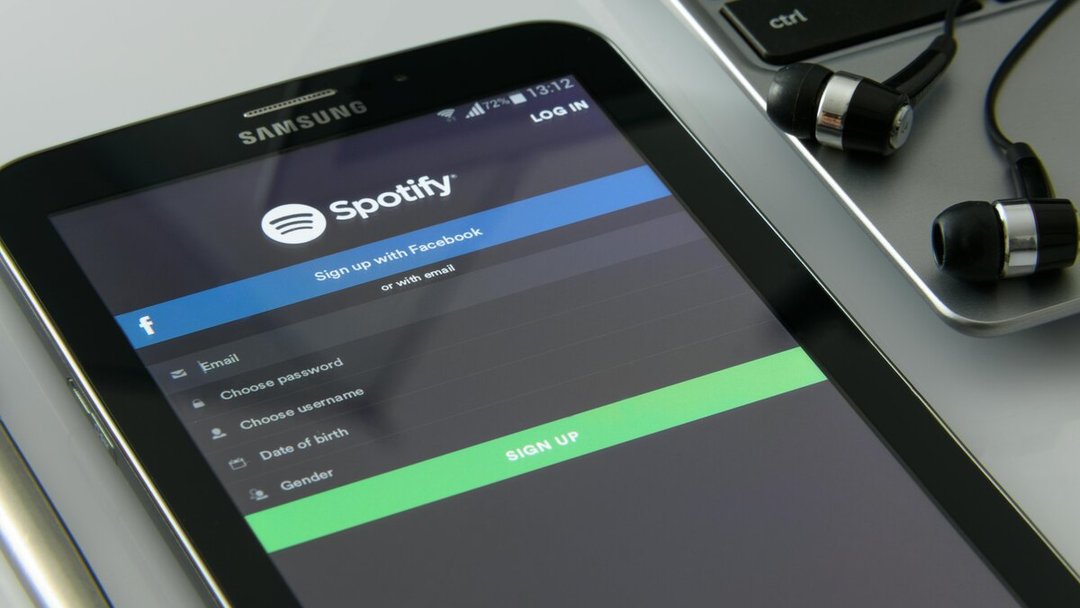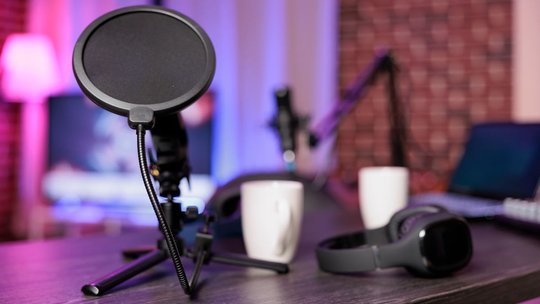Blog
How to Start a Podcast on Spotify: Your Complete Guide (2025)

Veröffentlicht am 16.2.2025 von Babalola Obafemi
PodcastingPodcasting has increased in popularity and reach over the years, and it doesn't look like it’ll stop anytime soon. To make it even better, Spotify is a widely known podcasting platform, and many podcast listeners use it daily. Big podcasters and podcasts like Joe Rogan and Crime Junkie are reaching thousands and millions of podcasters on Spotify every day.
So, if you’re considering starting a podcast on Spotify, you’re making the right choice. But you still need to put a few things in place.
This content contains the ultimate guide to starting a podcast on Spotify, the requirements, and other answers to your questions on starting a podcast on this platform. No fancy tools or complex setups are needed - all you need is the right information and you'll be good to go.
Why upload your podcast to Spotify?
Uploading your podcast to Spotify is an excellent choice for several reasons:
1. Wide audience reach
Spotify currently has the world's highest number of podcast listeners, and this number is continually increasing. Uploading your podcasts on Spotify helps you tap into this vast audience and reach listeners who might not find your podcast on other platforms.
2. Discovery potential
Spotify’s algorithm helps listeners discover new content based on their preferences. Recommendations, curated playlists, or search results are areas where Spotify could display your podcast to your audience. However, you have to do the right things to enjoy this benefit. Don’t worry; we’ll discuss all in the coming sections.
3. Analytics and insights
Spotify for Podcasters provides detailed podcast metrics and analytics, including data on audience demographics, streaming habits, and episode performance. These insights can help you understand your audience better and refine your content strategy.
4. Monetization opportunities
Spotify’s partnerships and programs, such as ads and subscriptions, can provide monetization opportunities for podcasters. This allows you to earn while creating content for your audience.
Spotify podcast requirements
Before starting your podcast on Spotify, there are a few requirements you need to keep in mind and implement;
1. Audio file specifications
- Format: Spotify supports MP3, M4A, and WAV audio file formats.
- Bitrate: Audio files should have a bitrate of 128–320 kbps.
- Sample Rate: The recommended sample rate is 44.1 kHz.
- Channels: Stereo is preferred, but mono is acceptable.
2. RSS Feed Requirements
Your podcast's RSS feed must include:
- A clear and unique podcast title.
- A compelling podcast description that briefly discusses what your podcast is about.
- A podcast cover art that meets Spotify’s specifications (see below).
- A title, description, and unique audio link for each podcast episode.
- A valid email address.
3. Podcast Cover Art
Spotify has strict guidelines for cover art:
- Minimum of 1400 x 1400 pixels, maximum of 3000 x 3000 pixels.
- JPEG or PNG under 512KB.
- RGB color mode.
- Clear, readable text and visually appealing graphics.
4. Content Guidelines
Spotify does not allow content that violates its terms of service. Some of these content types include:
- Illegal, explicit, or hate-promoting content.
- Violations of copyright or intellectual property laws. Ensure your podcast complies with Spotify’s content policies.
How to start a podcast on Spotify
- Plan your podcast
- Record and edit your podcast episode
- Submit and publish your podcast to Spotify
- Promote your podcast
1. Plan your podcast
Of course, planning adequately and appropriately is the best way to succeed in anything you’re starting. Planning your podcast involves several processes, like choosing and buying your podcast equipment and deciding your podcast type, topic, niche, episode content, etc. Ask yourself these questions to make decisions and plan appropriately:
- What is the goal of my podcast? Is it to entertain, educate, inspire, or just build authority in your niche?
- Who is your target audience? What are their interests, challenges, and preferences, and how will your podcast add value to them?
- What topic or niche will you focus on? Is it a subject you’re passionate about and knowledgeable in? Does it have enough scope to produce consistent and engaging content?
- What format will your podcast take: solo podcasting, co-hosting, interview-based, or storytelling?
- What podcast software or equipment do you need?
- What branding elements will you create?
- What is your episode plan? How often do you want to publish new content?
Extra tip: Read our ultimate guide on starting a podcast to help you even better.
2. Record and edit your podcast episode
After planning your podcast and you’re ready, record your first podcast episode. Set up a quiet environment to record. Use your chosen software to capture clear, high-quality audio. However, you can start by creating a podcast script if you have trouble speaking without a planned script. Remember your podcast script must contain a podcast intro, a main content section, and a closing segment. You can add other sections like listener shoutouts, Q&A sessions, sponsor messages, guest introductions, and call-to-actions depending on your choice, podcast type (solo or guest podcasting), and brand deals.
After recording, edit your podcast. Polish your episodes by removing errors, pauses, or background noise. Remove filler words like “uhh’, “ahhs,” and “ums” and background noises in your audio. Ensure your audio volume is the same throughout the episode so as not to piss your audience off. Finally, add intro/outro music if desired.
3. Create and set up your Spotify account
The next thing to do is to create an account on Spotify for Podcasters. Follow these steps to start:
- Head to the Spotify for Podcasters website
- Click on “Get Started” and sign up. You can enter your email and password or sign up with your Google, Facebook, Apple, or phone number.
- You’ll be asked if you already have a podcast or want to create a new podcast. Select “I want to start a new podcast.”
- Click on “Go to podcast setup” to create your podcast. Then, fill in your name, description, category, and language.
- Follow the instructions on your screen to complete the registration.
4. Submit and publish your podcast on Spotify
After setting up your account and creating it, ensure you are a verified creator. Also, remember to confirm your registration in your mail. There are two ways to submit and upload your podcast episode: upload an audio file or record your podcast directly on Spotify.
(If you have an existing podcast, check the next section of this content.)
Click “New episode” in the top left-hand corner of your account dashboard to start the process. For podcasters with pre-recorded audio or video, select “select a file” to get started. At the same time, those who would love to record their podcast live would be linked to the Riverside recording tool to complete their first audio. After uploading your file, optimize your podcast episode by filling in the details, like the unique episode name and descriptions. Add relevant keywords where possible to give your podcast episode a chance to appear in search results when the keyword is typed into the search bar.
Pro Tip: You can use SoundMadeSeen’s free transcription tool to generate podcast transcripts and other written content like podcast show notes, descriptions, social media content, blog content, etc, all from your podcast episode. Just upload your file to the tool and follow the steps.
5. Promote your podcast
After launching your podcast on Spotify, promotion is important to building an audience. Share your podcast to Instagram reels, TikTok, and other social media platforms, create engaging posts, and use relevant hashtags to reach your target audience. Collaborate with other podcasters and encourage listeners to leave reviews on your episode so you know how to improve and remodify your content to your audience's preference. Finally, create audiograms or teaser clips to attract potential listeners, drive traffic to your episodes, and leverage Spotify’s features like playlists to gain more visibility.
How to upload an existing podcast on Spotify
If you have an existing podcast and wish to expand your reach to Spotify, submitting your RSS link is your best option. To do that:
- Open a Spotify for Podcasters account.
- Select “Get Started” and sign up using the information you have available.
- You will be asked to choose between creating a new podcast or submitting an existing one. Select "I already have a podcast."
- Paste your podcast’s RSS link into the box.
- Submit the code sent to your email to verify that you are the podcast owner.
- Click “Submit” to finalize the process.
FAQs on starting a podcast on Spotify
Is it free to start a podcast on Spotify?
Yes, starting a podcast on Spotify is entirely free. All you have to do is open a Spotify for Podcasters account, set up your podcast, and begin to upload your podcast episodes.
How to start an existing podcast on Spotify?
Open a Spotify for Podcasters account to add an existing podcast to Spotify. Set up your account by adding your name, email, podcast name, and other details requested. Enable automatic distribution of your podcast episodes to Spotify and copy your RSS link. Head to Spotify and select “I already have a podcast.” Paste your podcast’s RSS link into the box and verify ownership of the podcast.
Beginnen Sie kostenlos zu erstellen
Verwandeln Sie Ihren Podcast, Ihr Hörbuch oder Ihren Vortrag in teilbare Video- und Textinhalte
Probieren Sie es heute aus


